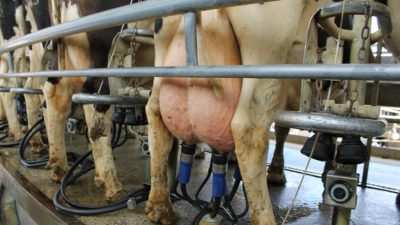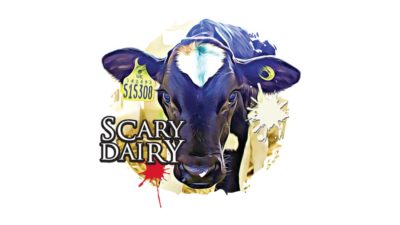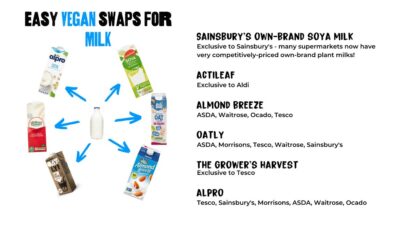A comparison between human milk and cow’s milk
The composition of milk varies according to the animal from which it comes, providing the correct rate of growth and development for the young of that species, thus for human infants, human milk is obviously more suitable than cow’s milk. Indeed, the popular consensus among health care professionals is that ordinary cow’s milk, goat’s milk, condensed milk, dried milk, evaporated milk, or any other type of milk should not be given to a child under the age of one. This is because of differences in the composition of milk that have been revealed by research over the last decade or so. While cow’s milk and human milk contain a similar percentage of water, the relative amounts of carbohydrate, protein, fat, vitamins and minerals vary widely.
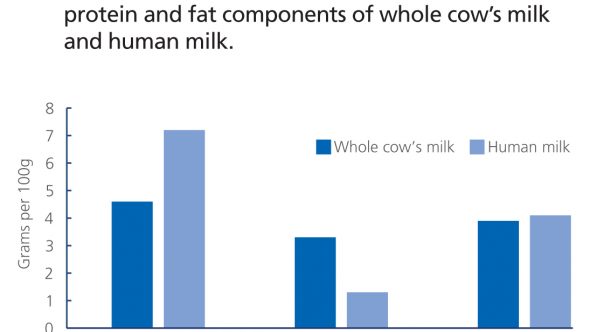
Protein
The carbohydrate, protein and fat content of milk from one species is finely tuned to meet the nutritional requirements of that particular animal whether human, elephant, buffalo, camel or dog. Figure 2.0 shows that the protein content in 100g of whole cow’s milk (3.3g) is more than double that of human milk (1.3g); this is because the amount of protein in milk is linked to the amount of time it takes that particular species of animal to grow in size. Growing calves need more protein to enable them to grow quickly. Human infants on the other hand need less protein and more fat as their energies are expended primarily in the development of the brain, spinal cord and nerves.
Species with the highest milk protein concentration exhibit the most rapid growth rate. Leucine is a unique amino acid in that it stimulates muscle protein synthesis. The higher the protein plus leucine content of milk, the quicker the neonate doubles its birth weight. For instance, the leucine content of rat’s milk is 11 grams per litre and the rat doubles its birth weight in just four days. Cat’s milk contains 8.9 grams per litre and the cat takes 10 days to double its birth weight. Cow’s milk contains 3.3 grams per litre and the calf doubles its birth weight after 40 days. Human milk contains 0.9 grams per litre and the human infant, the mammal with the slowest growth rate, doubles its birth weight after 180 days. The weight gain of calves during the first year (0.7-0.8 kg per day) is nearly 40 times higher than that of breastfed human infants (0.02 kg per day). It has been demonstrated that cow’s milk-based infant formula feeding significantly increases serum concentrations of leucine, insulin and IGF-1 in comparison to breast-feeding (Melnik et al., 2012). This may be one of the mechanisms linking formula feeding to overweight and obesity (see Breast Is Best below).
The proteins in milk can be divided into two categories: caseins and whey proteins. Human milk contains these in a ratio of 40:60 respectively; while in cow’s milk the ratio of casein to whey proteins is 80:20. Given that the amount of total protein in cow’s milk is more than double that of human milk, cow’s milk clearly contains considerably more casein than human milk. Casein can be difficult to digest, in fact it is used as the basis of some glues! Infant milks are formulated to contain more whey than casein (the ratio of whey to casein in these milks is similar to that of human milk), and this is why it is thought to be easier for new babies to digest. Casein has been linked to a range of diseases and allergies, including type 1 diabetes (see Diabetes).
Fat
The amount and type of fat present in the milk similarly reflects the requirements of the species of animal producing that milk. Whole milk from a cow contains around four per cent fat whereas milk from the grey seal contains over 50 per cent fat (Baker, 1990); this is because baby seals need more body fat to survive in cold water. Figure 2.0 shows that 100g of whole cow’s milk and human milk contain similar amounts of fat (3.9g and 4.1g respectively). While these values are close, the types of fat vary. Figure 3.0 shows that cow’s milk contains more saturated fat while human milk contains more unsaturated fat.
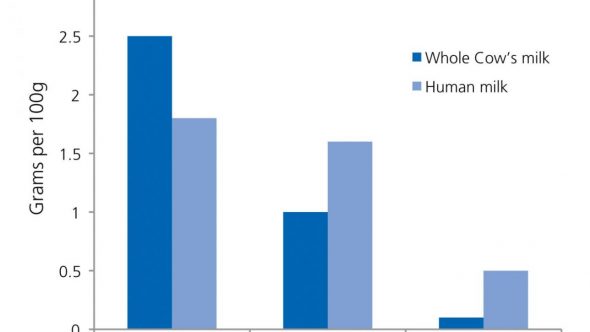
Figure 3.0 shows that 100g of whole cow’s milk contains 2.5g saturated fat, 1.0g monounsaturated and 0.1g polyunsaturated fat, while human milk contains 1.8g saturated fat, 1.6g monounsaturated fat and 0.5g polyunsaturated fat (FSA, 2002). These figures demonstrate the higher level of saturated fat in cow’s milk compared to human milk, and the higher level of unsaturated fat in human milk compared to cow’s milk. This imbalance contributes to the unsuitability of cow’s milk for human infants.
The higher level of unsaturated fatty acids in human milk reflects the important role of these fats in brain development. In humans the brain develops rapidly during the first year of life, growing faster than the body and tripling in size by the age of one. The brain is largely composed of fat and early brain development and function in humans requires a sufficient supply of polyunsaturated essential fatty acids. The omega-6 fatty acid arachidonic acid (AA) and the omega-3 fatty acid docosahexaenoic acid (DHA) are both essential for brain development and functioning. Both are supplied in human milk but not in cow’s milk (currently AA and DHA-enhanced infant formulas are available, although not mandatory, throughout most of Europe). Cow’s milk does contain the shorter chain omega-6 linoleic acid (LNA) and the omega-3 α-linolenic acid (ALA) but these have to be converted in the body into the longer chain versions mentioned above.
A review of 20 studies of cognitive function of breast fed infants compared to that of formula fed infants concluded that the nutrients in breast milk may have a significant effect on neurological development in infants (Anderson et al., 1999). More recent work indicates that compared to formula milk, nutrients in breast milk may confer better cognitive and motor development in infants (Bernard et al., 2013) which may extend into intelligence in adulthood (Mortensen et al., 2003).
Cow’s milk tends to be low in the types of fat essential for human brain development; a rapid increase in body size is more of an imperative for cows than rapid brain development, so cows produce milk that is high in body-building saturated fats to help their calves grow rapidly in size. Similarly, the fatty acid composition of cow’s milk is more suited to a calf than to a person. Attempts to alter the fatty acid composition of cow’s milk, and so increase the nutritional value of cow’s milk to humans, have involved experiments feeding cows fish meal and soya beans (AbuGhazaleh et al., 2004) and flax seed (Petit, 2002). Feeding flax seed resulted in a lower omega-6 to omega-3 fatty acid ratio, which is thought might improve the nutritional value of milk from a human health point of view by reducing the potential risk of disease. Of course you could just eat the flax seed oil yourself to improve the balance of omega-3 and omega-6 oils in your diet while avoiding the undesirable components of milk.
| Cow's Milk (semi-skimmed, pasteurised) per 100g | Human Milk (mature) per 100g | |
| Sodium (mg) | 43 | 15 |
| Potassium (mg) | 156 | 58 |
| Calcium (mg) | 120 | 34 |
| Magnesium (mg) | 11 | 3 |
| Phosphorus (mg) | 94 | 15 |
| Iron (mg) | 0.02 | 0.07 |
| Copper (mg) | Trace | 0.04 |
| Zinc (mg) | 0.4 | 0.3 |
| Chloride (mg) | 87 | 42 |
| Manganese (mg) | Trace | Trace |
| Selenium (ug) | 1 | 1 |
| Iodine (ug) | 30 | 7 |
| Retinol (ug) | 19 | 58 |
| Carotene (ug) | 9 | 24 |
| Vitamin D (ug) | Trace | Trace |
| Vitamin E (mg) | 0.04 | 0.34 |
| Thiamin (mg) | 0.03 | 0.02 |
| Riboflavin (mg) | 0.24 | 0.03 |
| Niacin (mg) | 0.1 | 0.2 |
| Vitamin B6 (mg) | 0.06 | 0.01 |
| Vitamin B12 (mg) | 0.9 | Trace |
| Folate (ug) | 9 | 5 |
| Pantothenate (mg) | 0.68 | 0.25 |
| Biotin (ug) | 3.0 | 0.7 |
| Vitamin C (mg) | 2 | 4 |
Table 2.0 Comparison of the mineral and vitamin components of cow’s milk and human milk.
() = estimated value. Source: FSA, 2002.
Calcium
The calcium content of cow’s milk (120mg per 100ml) is nearly four times that of human milk (34mg per 100ml). This discrepancy occurs for good reason; calves grow much more quickly and have a larger skeleton than human babies and therefore need much more calcium (FAO, 1997). Cow’s milk is specifically designed to meet this high demand which is why whole cow’s milk is not recommended for infants under 12 months. Although human milk contains less calcium, it is more easily absorbed than that found in cow’s milk. According to the American Academy of Pediatrics Committee on Nutrition, the available data demonstrate that the bioavailability of calcium from human milk is greater than that from infant formulas (58 per cent and 38 per cent respectively) (Greer and Krebs, 2006). In an effort to address this discrepancy, the concentration of calcium in infant formulas is generally higher than that in human milk. So although human milk contains less calcium than cow’s milk, the calcium in human milk is better absorbed into the body than the calcium in cow’s milk, again illustrating why human milk is the best source of nutrition during the first year of life.
Iron
Cow’s milk contains very little iron (FSA, 2002) which is another reason why cow’s milk is deemed to be unsuitable for infants under the age of 12 months. Indeed a one-year-old attempting to meet the reference nutrient intake (RNI) of 5.3mg of iron would have to drink over 30 pints of cow’s milk per day if it were to be used to meet their iron requirement. Furthermore, cow’s milk is low in vitamin C and vitamin D (Department of Health, 1994), and contains less vitamin A than human milk.
The high protein, sodium, potassium, phosphorus and chloride content of cow’s milk present what is called a high renal solute load; this means that the unabsorbed solutes from the diet must be excreted via the kidneys. This can place a strain on immature kidneys forcing them to draw water from the body thus increasing the risk of dehydration. The renal solute load of infants fed cow’s milk has been shown to be twice as high as that of formula fed infants (Martinez et al., 1985) and three times that of human milk (Ziegler, 2011).
Allergic reactions to the proteins in cow’s milk are common among infants, and cow’s milk-induced intestinal bleeding as an allergic response is a well recognised cause of rectal bleeding in infancy (Willetts et al., 1999). This blood loss can affect the iron nutritional status of the infant (Ziegler et al., 2011) and in many cases may lead to anaemia. This condition will deteriorate if iron-rich foods are excluded by the continued consumption of milk, a food very low in iron (see Allergies – Gastrointestinal bleeding).
The health problems caused by the early consumption of ‘normal’ off-the-shelf cow’s milk are so well documented that for some time now, parents and caregivers have been advised not to introduce cow’s milk before the age of 12 months in the UK (Department of Health, 1994), the US (American Academy of Pediatrics, 1992), Denmark (The National Board of Health, Denmark, 1998) Canada (Canadian Paediatric Society, 1998), Sweden (Axelsson et al., 1999) and New Zealand (Soh et al., 2004).
This is an excerpt from Viva! Health’s White Lies report.




